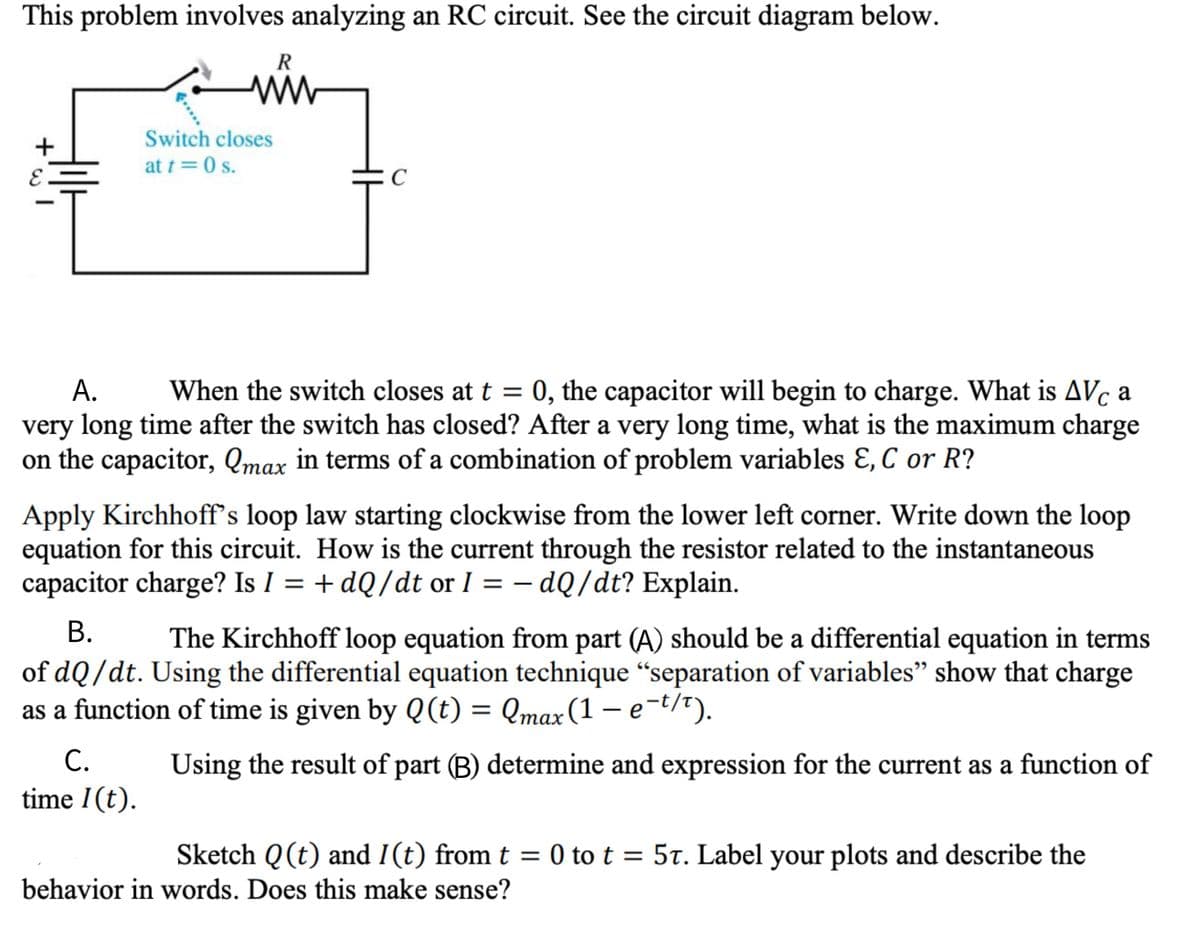R Switch closes at t=0 s. А. rery long time after the switch has closed? After a very long time, what is the maximum charge on the capacitor, Qmax in terms of a combination of problem variables E, C or R? When the switch closes at t = 0, the capacitor will begin to charge. What is AVc a Apply Kirchhoff's loop law starting clockwise from the lower left corner. Write down the loop quation for this circuit. How is the current through the resistor related to the instantaneous apacitor charge? Is I = + dQ/dt or I = – dQ/dt? Explain. В. of dQ/dt. Using the differential equation technique “separation of variables" show that charge s a function of time is given by Q(t) = Qmax(1 – e-t/t). The Kirchhoff loop equation from part (A) should be a differential equation in terms %3D С. ime I(t). Using the result of part (B) determine and expression for the current as a function of Sketch Q(t) and I(t) from t = 0 to t = 5t. Label your plots and describe the pehavior in words. Does this make sense? .....
R Switch closes at t=0 s. А. rery long time after the switch has closed? After a very long time, what is the maximum charge on the capacitor, Qmax in terms of a combination of problem variables E, C or R? When the switch closes at t = 0, the capacitor will begin to charge. What is AVc a Apply Kirchhoff's loop law starting clockwise from the lower left corner. Write down the loop quation for this circuit. How is the current through the resistor related to the instantaneous apacitor charge? Is I = + dQ/dt or I = – dQ/dt? Explain. В. of dQ/dt. Using the differential equation technique “separation of variables" show that charge s a function of time is given by Q(t) = Qmax(1 – e-t/t). The Kirchhoff loop equation from part (A) should be a differential equation in terms %3D С. ime I(t). Using the result of part (B) determine and expression for the current as a function of Sketch Q(t) and I(t) from t = 0 to t = 5t. Label your plots and describe the pehavior in words. Does this make sense? .....
Related questions
Question
100%

Transcribed Image Text:This problem involves analyzing an RC circuit. See the circuit diagram below.
Switch closes
at t = 0 s.
А.
When the switch closes at t = 0, the capacitor will begin to charge. What is AVc a
very long time after the switch has closed? After a very long time, what is the maximum charge
on the capacitor, Qmax in terms of a combination of problem variables Ɛ, C or R?
%3D
Apply Kirchhoff's loop law starting clockwise from the lower left corner. Write down the loop
equation for this circuit. How is the current through the resistor related to the instantaneous
capacitor charge? Is I = + dQ/dt or I = – dQ/dt? Explain.
|
В.
The Kirchhoff loop equation from part (A) should be a differential equation in terms
of dQ/dt. Using the differential equation technique “separation of variables" show that charge
as a function of time is given by Q(t) = Qmax(1 – e-t/t).
С.
Using the result of part (B) determine and expression for the current as a function of
time 1(t).
Sketch Q (t) and I(t) from t = 0 to t = 5t. Label your plots and describe the
behavior in words. Does this make sense?
Expert Solution
This question has been solved!
Explore an expertly crafted, step-by-step solution for a thorough understanding of key concepts.
This is a popular solution!
Trending now
This is a popular solution!
Step by step
Solved in 5 steps with 2 images
